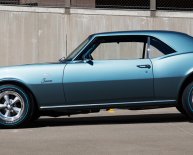October 11, 2016

Classic car Insurance Companies

Collector Car Insurance Questions to Discuss With Your Independent Agent
As a classic car owner, you have a lot invested in that '67 Camaro, or that '56 Continental, or that '77 Volkswagen bus. And, we’re not just talking money. You have as much – if not more – of an emotional investment in the car as you do a financial one. After all, it’s not just transportation. It’s a prized possession.
Here are a few classic car insurance questions you'll want answered as you decide how you want to protect your investment—financial and emotional.
- How old does it have to be? States, car clubs and insurers all define "classic" differently, but insurers' age limits tend to be a bit broader than most. A typical classic car insurance qualification may require a car to be at least 10 years old to be a “classic” and at least 25 years old to be an “antique.” Age isn’t the only classic car insurance qualification, however. Some insurers may require the car to have unique value, such as being a limited edition.
- How do I choose a carrier? Look for a carrier that will insure your collector car with agreed value coverage. Here’s what that means: You and your insurer agree on a value for your car, based on its market value and condition. If the car is declared a total loss after a theft or damage, you receive that amount, minus any deductible you may have. Depreciation is not a factor. As your car increases in value, be sure to increase your agreed value coverage, too.
- Who actually provides the policy? Several companies specialize in classic car insurance, and many mainstream insurers partner with those companies to offer coverage. If you plan to purchase classic car insurance from your current carrier, it's worth asking if it will provide the policy or if an entirely different carrier will. If it’s the latter, ask whether that will affect the logistics of billing and filing claims. It's also worth asking if you can still get a multi-car discount if your regular vehicle is covered by your insurer and your classic is covered by your insurer's partner.
- Are there limits on how much I can drive? Some policies permit only driving for car club activities or car shows, or only on weekends or holidays. Others permit driving up to 5, 000 miles, or even 10, 000 miles, per year.
- Do I need a garage? Many, perhaps most, classic car insurers require that the vehicle be kept in an enclosed, locking garage or storage facility. No garage, no coverage.
- Can I let others drive my classic? Possibly not. “Attendance” clauses require that the classic car be accompanied by its owner whenever it's out of the garage and in use. These are less common than the garage requirement.
- What about repairs and roadside assistance? Repair parts for classics can be hard to get and thus pricier than for ordinary cars, so it's worth checking what level of coverage is available. And, some policies guarantee flatbed towing with soft straps as part of their roadside assistance coverage. Keep in mind that roadside assistance is typically an optional coverage you’ll need to add to your policy, if you like.
- How can I pay less for classic car insurance? If you insure a collector car with the same carrier as you insure your everyday vehicle, you may qualify for a discount. Furthermore, if you store your classic car for several months out of the year, such as during the winter, you may be able to reduce your coverage and pay less while it’s in secure storage.
- How about racecars? Some insurers exclude racers while others will cover them. It's not uncommon, however, for insurers to exclude racecars and dragsters that use nitrous oxide engines.

















